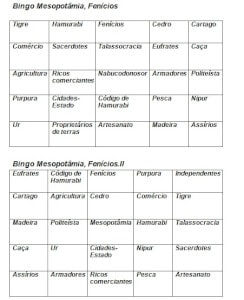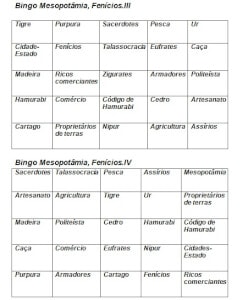
History Activity, proposed to students in the sixth year of elementary school, this is a playful exercise for learning issues related to Mesopotamia and Phoenicians. This activity contains a Bingo with the answers to the questions below.
This story activity is available for download in an editable Word template and ready to print in PDF.
Download this activity from:
SCHOOL: DATE:
PROF: CLASS:
NAME:
1) Which rivers surround the Mesopotamian region?
Tiger and Euphrates.
2) What is the first law code in history?
Code of Hammurabi.
3) Ruler who was known for drafting a code of laws.
Hammurabi.
4) Main products marketed by the Phoenicians.
Wood and purple.
5) Wood used by the Phoenicians to build boats.
Cedar.
6) Main Phoenician colony whose main purpose was trade.
Cartago.
7) The domain of traders in politics is called:
Thalassocracy.
8) Factor that favored the growth of powerful cities.
Commerce and crafts.
9) Phoenicia did not become a unified state, as the region was organized around cities:
Independent.
10) As happened in other ancient peoples, there was social inequality among the Phoenicians. There was the dominant group of:
a) Wealthy merchants.
b) Land owners.
c) Shipowners.
d) Priests.
11) Phenicia, a region that currently corresponds to Lebanon, was a narrow area surrounded by the Mediterranean sea and mountains. In this region the Phoenicians practiced:
a) Agriculture.
b) Hunting.
c) Fishing.
12) Mesopotamian society was ___________. Their gods represented phenomena of nature.
Polytheist.
13) With the death of Hammurabi, the Babylonian Empire fell into decay and divided into several independent kingdoms, which weakened and facilitated the invasion of:
Assyrians.
14) The Sumerians were the first people to settle in southern Mesopotamia, where they founded:
City-States.
15) The Sumerians were the first people to settle in southern Mesopotamia, where they founded influential city-states. The main ones were:
a) Ur.
b) Nippur.
c) Lagash.
d) Eridu.
16) In all societies, writing was an activity reserved for a few; in ancient societies, later until the Sumerians, those who occupied themselves with writing were called:
Scribes.
17) The economic base of Mesopotamian society was agriculture, benefited by rivers and by:
Fertile lands.
18) Scholars assure that the first libraries emerged in:
Mesopotamia.
19) Another fundamental element of urban life that emerged in Mesopotamia developed by the Sumerians was the invention of:
Writing.
20) Mesopotamian art was closely associated with religion. The palaces had walls decorated with bas-reliefs. The most famous temples in Sumer were:
Ziggurats.
21) Around 620 a. a., the inhabitants of the Chaldean, in the south of Mesopotamia, were united to the medos. Together they defeated the Assyrians and rebuilt the Babylonian Empire. The second Babylonian Empire emerged more than a thousand years after the first. Its most prominent king was:
Nebuchadnezzar.
The teacher draws a number, however, just to have a reference of which question to read. After reading the question, the student must know the answer to mark on the table. All answers are correct. Whoever scores first vertically, horizontally or full card wins. The award is at the discretion of the teacher.





By Rosiane Fernandes Silva – Graduated in Letters
At answers are in the link above the header.
 report this ad
report this ad
